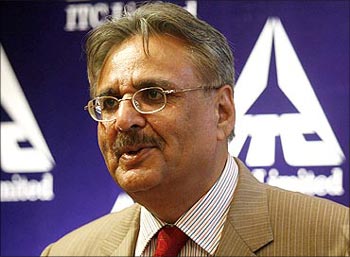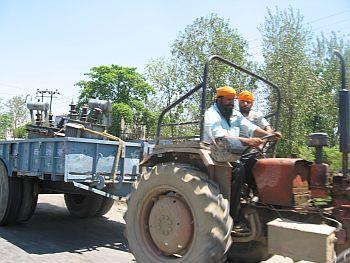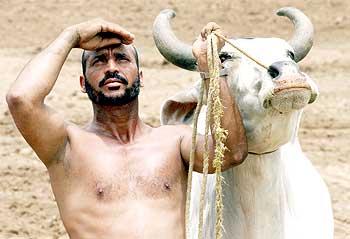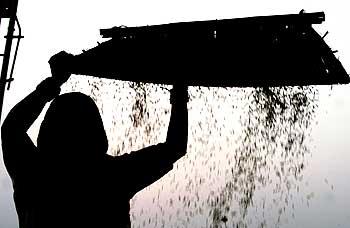 | « Back to article | Print this article |
E-choupals: Deveshwar's dream gets hazy
ITC Chairman Y C Deveshwar wanted to do a Walmart with e-choupals, which leveraged the Internet to empower small and marginal farmers by linking them directly with buyers. It was his showcase project and Deveshwar made sure he walked the talk.
But 10 years after the launch of the project, both the walk and the talk are showing signs of faltering.
Launched in 2000 with six installations, the number of e-choupals grew to 6,500 in 2007, and at one point of time, ITC was opening six such choupals a day.
The largest such online initiative for farmers made for numerous case studies, including at the Harvard Business School and C K Prahalad's 'The Fortune at the Bottom of the Pyramid'.
The target then was to have 20,000 e-choupals, covering 100,000 villages, by 2010.
Click NEXT to read further. . .
E-choupals: Deveshwar's dream gets hazy
Three years later, however, much of the zing is missing, as the number has remained stagnant at 6,500. "The 10-year old boy stopped growing after age seven," said an industry insider.
The reason is predictable.
Export bans, subsidies, stock controls, prohibition of futures and slow amendment to the Agriculture Produce Marketing Committee Act, have adversely affected the scale, risk and profitability of e-choupal operations.
Amendment to the APMC Act is necessary for direct procurement from farmers.
S Sivakumar, chief executive of the agribusiness division of ITC and architect of the e-choupal, said for all practical purposes, expansion of e-choupals stopped in 2007, after several ongoing policy reforms in the agriculture sector were reversed or slowed down.
No new e-choupals are being set up at this time.
Click NEXT to read further. . .
E-choupals: Deveshwar's dream gets hazy
So, does the scaling up target look impossible now? Sivakumar only said that "the target will be reviewed if and when the reforms are back on track".
The e-choupal model enables farmers to obtain information on mandi prices and good farming practices, and to place orders for agricultural inputs like seeds and fertilisers. Each kiosk having Internet access is run by a sanchalak, a trained farmer.
The computer is housed in the sanchalak's house and is linked to internet via phone lines or by a very small aperture terminal connection.
Each installation serves an average of 600 farmers in the surrounding 10 villages within about a five km radius.
The sanchalak bears some operating cost, but in return earns a service fee for the e-transactions done through his e-choupal.
Click NEXT to read further. . .
E-choupals: Deveshwar's dream gets hazy
The model was meant to be a win-win. While farmers benefit through enhanced farm productivity and higher farm gate prices, ITC benefits from the lower net cost of procurement, having eliminated costs in the supply chain that do not add value.
But all this is not possible in states where the APMC Act is yet to be amended. The amendment to the APMC Act, of course, has derailed many agri-related initiatives, not just the e-choupal.
According to government data, six states -- Andhra Pradesh, Bihar, Maharashtra, Madhya Pradesh, Uttar Pradesh and West Bengal -- account for more than 50 per cent of total regulated markets in the country.
Ironically for ITC, the biggest facilitator has turned out to be the biggest challenge -- policy reforms, even though it found mention in the government's Economic Survey of 2006-07 for its transformational impact on rural lives.
Click NEXT to read further. . .
E-choupals: Deveshwar's dream gets hazy
Riding on the success, the e-choupal scheme was extended to a hub and spoke version Choupal Saagar or the rural marketing hub.
Choupal Saagar mainly function as agri sourcing centres, shopping centres and facilitation centres, delivering a host of farm-related activities. ITC planned to have 40 such centres by 2007 and 100 by 2010.
But the milestone stopped early and at present, there are 24 Choupal Saagars.
"In 2007, further expansion of Choupal Saagars was also stopped," Sivakumar said.
Choupal Fresh, the retail and wholesale vending of fruits and vegetables, is still operating as a pilot project.
Launched in 2007, it was supposed to add 140 stores in 54 towns by 2010-11.
Click NEXT to read further. . .
E-choupals: Deveshwar's dream gets hazy
The stumbling blocks have been many, but ITC is not giving up. Neither is Sivakumar.
"Since most of these policy restrictions are on agri commodity buying, we are exploring new anchor businesses in agri-extension and employment exchange domains," Sivakumar said.
The e-choupal is running version 3.0. Last year, online career and recruitment resource Monster India and e-choupal formed an alliance to launch Rozgarduniya.com, aimed at job seekers in rural India, who could access and apply for jobs through the e-choupals.
Meant to be one of the biggest grossers for ITC, what kind of revenues have the many versions translated to, for the firm? ITC won't tell.






